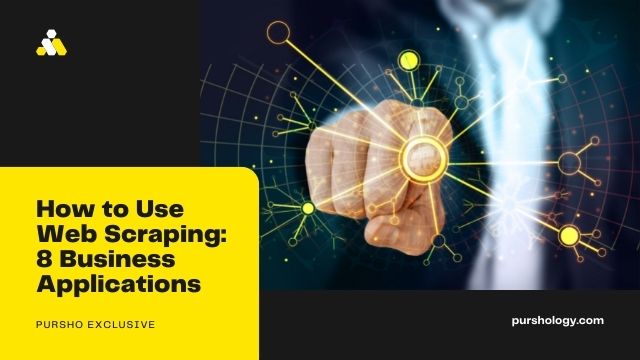The Internet is a data storage facility for all the information in the world, whether it is text, media, or data in another format. Access to this information is important to the success of many businesses.
Sadly, the majority of this information is not accessible. Often, websites do not allow you to save the data they exhibit to your local storage or your own website. And that is where web scraping software can come in handy.
Web scraping has numerous applications for both business and personal needs. This article will go over some of the most common use cases.
What Is Web Scraping?
Web scraping is the process of retrieving data from websites to your computer or database automatically. Web scraping software can go through several pages on a website and automate the time-consuming job of manually copying and pasting the displayed data. Typically, the data is downloaded in tabular (spreadsheet) format.
If you’ve already copied and pasted data from websites, you’ve done the same thing as a web scraper, albeit on a much smaller, manual scale. Web scraping, as opposed to the tedious, mind-numbing procedure of manually extracting data, uses an advanced automation system to fetch hundreds, millions, or even billions of pieces of data from the Internet’s seemingly limitless supply.
Web Scraping Use Cases
In general, web data extraction is being used by individuals and businesses who want to make better decisions by utilizing the huge amount of publicly available web data. Among the many applications of web scraping are price monitoring, lead generation, price intelligence, news monitoring, and market research.
1. Market Analysis
When considering starting or expanding a business, market research is the most significant source of information and a good place to start, especially in complex industry segments. The more data there is, the better. Businesses can access high volume, high quality, and highly insightful web data through web scraping, which can be a major turning point in decision making.
You can use a web scraping API on relevant websites to run market trend analysis, optimize point of entry, market pricing, or use the data for development and research purposes. All of this begins with information that can be extracted and downloaded in a very malleable format by using a web scraping API.
2. Product and Price Information
Another common reason for businesses or entrepreneurs to use web scraping software is to collect information about competitors’ prices and products, such as available stock or description of the product. By streamlining pricing strategies and market positioning, this is a common practice that can secure business growth and continuity.
Pricing is always difficult. Even more so when it is dynamic and your competition is following suit. Then toss in thousands of items. There is only one possible outcome: madness.
You can, however, do better. And price monitoring through data automation will assist you in getting there. Keep a watch on your products and your competitors’ products, compare them, and gain valuable insights. Receive alerts when prices fluctuate or competitors add or remove products. Everything that can be done manually can be digitized.
Explore dynamics or new product categorization as soon as your competitors do. Review your competition’s history to get a head start on seasonalities and be the first to launch your product this year.
3. Machine Learning with a Boost
Machine learning is one of the most exciting and talked-about technological developments. Truly, AI-powered solutions can and will have a significant influence on many areas in the coming decades. However, machine learning is far from simple. The fundamental principle is that programmers must train their algorithms to function effectively on their own. They will need a vast amount of high-quality sample data for this.
For example, if your model is based on animal image recognition, you might want to collect a large number of images. You could do it merely by searching for pictures on Google, but if you need a larger scale, website scraping can provide it. What’s more, why not tag the images for supervised learning? Images are usually labeled or captioned with descriptive text about the animal.
These results could be scaled to thousands of labeled images from various sources. However, there are additional benefits to doing this data extraction on a regular basis: a continuous stream of insight. Assume you visit multiple nature magazines each week to collect all of these images and add them to your collection.
The same is true for text and other forms of content. Simply point the scraper to the correct track, validate the data for accuracy, and then feed it to the algorithm. The specifics of the data extraction process are determined solely by the specifics of the machine learning project the individual is working on.
4. Using Accessible, Actionable Data to Modernize the Real Estate Industry
Through the use of web scraping, the real estate sector as a whole has seen a significant improvement. Property listing websites are prime, well-known examples. These platforms use web scraping to collect offers from all over the Internet and display them all in one place.
Businesses and individuals can find all available prospects in one place, rather than having to browse individual realtor websites or depend solely on an agent to bring them a catalog.
Crawlers and scrapers are used by the majority of these aggregator sites around the clock. Their offers do not need to be manually entered because a script instantaneously uploads the data.
However, the advantages do not end with improved quality of life. Data extraction shines in large-scale projects with a large amount of information to collect and process. The real estate industry is exactly that kind of place.
Both investors and realtors have to know where the market is headed, both in general and in specific places (cities or even neighborhoods). To know that, you must have data on as many similar properties as possible.
We’re speaking about property valuations, vacancy rates, sales cycles, asking prices, and so on. All of that data, once collected and processed, becomes critical in decisions such as when and where to buy, sell, or rent.
5. Data-driven Hiring
It is rarely easy to attract top talent to your organization. Even if your company has a stellar reputation and excellent benefits, recruiters’ jobs are never easy.
Using extracted data to better understand the job market is one way to make your work easier. For example, if you’re looking for a product designer, the first step would be to look for other job opportunities in the same field. Visit job boards, scrape relevant data, and compile it all into a single file.
Examine the company names in that record. They are your competitors as they are searching for the same things you are. Examine the information, such as offered wages, job descriptions, benefits, and so on, to see what you need to beat to have the brightest and best on your team.
6. Generating Leads
Having access to a potential customer list for your company can give you a significant competitive advantage, especially if you have a B2B business. In fact, utilizing online web scraping tools is one of the most vital email marketing best practices. But it will take some time to do this the hard way (with copy and paste).
That is why businesses use web scraping. It is one of the most frequently used tools by those working in sales and/or business development for lead generation. They can use such a tool to download large contact lists – lists full of potential prospects – from websites such as LinkedIn or anywhere else in a fraction of the time.
7. Brand Monitoring
The desire to understand how people think and feel about companies began to grow in the minds of owners, prompting them to search online for reviews.
In this case, the Internet’s immense power can be a burden. Consider scrolling through hundreds of websites in search of evidence that customers like or dislike your product. Marketing and public relations teams can keep track of all these opinions by using a web scraping API.
A web sScraping API can gather data much more quickly and store it in a systematic format. To monitor your brand via social media, having a tool such as a Twitter scraper to understand what customers are saying about your product would be helpful. As a result, calculating general opinion, comparing it to previous intervals, and identifying trends and unhappy customers is much easier.
8. Search Engine Optimization
Few businesses will consider using web scraping for SEO. It can assist you in gathering the necessary data to improve your presence online on search engines. Keywords and backlink opportunities will be available to you.
Web scraping can be used for SEO in a variety of ways. You can scrape SERPs, conduct competitor research, look for backlink opportunities, and identify influencers!
Closing Thoughts
As you may have already realized, web scraping can be used in a variety of ways. In fact, the use cases we’ve highlighted are only the tip of the iceberg.
Every additional piece of information a company can obtain prior to making a decision influences the outcome. There is no need for every company to dive headfirst into data analysis. To get there, you must first extract that information, and website scraping is a great way to do so.




